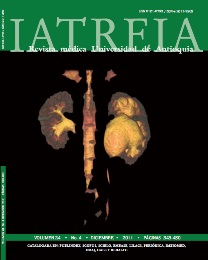Cockayne syndrome: report of two clinical cases and review of the literature
DOI:
https://doi.org/10.17533/udea.iatreia.10641Keywords:
Cockayne Syndrome, Photosensitivity, Premature AgingAbstract
Introduction: Cockayne syndrome is an autosomal, recessive genetic disorder, characterized by poor growth, development impairment, premature aging, and photosensitivity. Prevalence is 1/100.000 live births, and it is more frequent in males with a ratio of 3:1. From the genetic point of view two groups have been described: Group A: mutation of the CSA gene (CKN1, ERCC8) on chromosome 5q12. Group B: mutation of the CBS gene (ERCC6) on chromosome 10q11. We report two cases that were diagnosed solely on clinical bases because no genetic studies were available.
Case 1. A school-girl, born from consanguineous parents. Since birth she has suffered from hypotonia and hypomotility. She has development delay, low weight and height gain, aged face, dysmorphic features, photosensitivity, spasticity, sensorineural hearing loss, and typical findings in the CT scan. She is currently on rehabilitation.
Case 2. A female teenager with seizures from the age of two months; she made slow progress in psychomotor development, and had low weight and height gain. Her features were dysmorphic and her face aged. She had bilateral sensorineural hearing loss, and repeated dystonias. She suffered from repeated respiratory infections and died, aged 14, from respiratory failure secondary to bilateral pneumonia.
Conclusion: We report these two cases and a review of the literature in order to attract attention to Cockayne syndrome so that early diagnoses can be made in children with psychomotor development delay, premature aging and photosensitivity. Early diagnoses are the basis for genetic counseling.
Downloads
Downloads
Published
How to Cite
Issue
Section
License
Papers published in the journal are available for use under the Creative Commons license, specifically Attribution-NonCommercial-ShareAlike 4.0 International.
The papers must be unpublished and sent exclusively to the Journal Iatreia; the author uploading the contribution is required to submit two fully completed formats: article submission and authorship responsibility.














